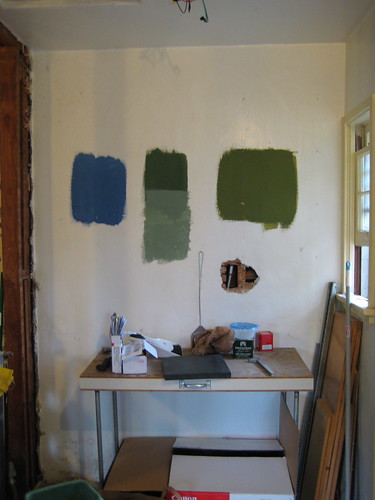The Milk Paint formula is based on the way people used to make their own paint using cow's milk and limestone. The modern formulation from the Milk Paint company contains milk protein (casein) and lime, plus natural pigments like ochre and iron oxide. Milk Paint is free of VOCs (volatile organic compounds) and other potentially toxic substances and is biodegradeable. So, it's an extremely environmentally friendly paint. In fact, it's so nice and natural that it doesn't even smell bad.
Last week, we received several Milk Paint samples in the mail. The paint is shipped as a powder, and then you just add water to make paint. This also allows you to mix it thicker or thinner, depending upon what kind of coat you need.
Right now, we're deciding between a couple of different shades of green for the cabinets and walls. Because they use natural pigments, Milk Paints don't come in an endless supply of hues, but there's definitely a nice selection. And all the colors have a warmth that I think will suit our Shaker/modern design nicely.
So, will it be Bayberry Green or Lexington Green? Decisions, decisions...



I love the green on the right side.
so do I.
Have you used milk paint before? If not,I suggest that you see if you have any large surfaces left over from the demolition and paint it with the milk paint to get a feel for how if spreads. I used some to paint a plaster room that had never been painted and it really got absorbed quickly. It did not go on evenly (this was not a problem for me as I liked the overall effect. It took twice as much paint as I thought it would. I was using a light color. It was a pain to mix and a pain to use. Iti would have been easier if I had had a good place to sort of practice with it.
seventh sister, thanks for the tip. I think we're actually going to use a special formulation from the Milk Paint people called Safe Paint that's supposed to go on more evenly and work better on walls. I'll be sure to do a test area, though. I'll let you know how Safe Paint works out.